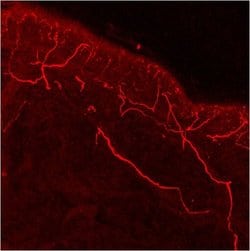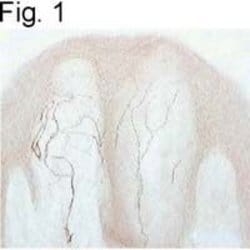Learn More
Invitrogen™ TRPV1 Polyclonal Antibody
Rabbit Polyclonal Antibody
Supplier: Invitrogen™ PA1748
Description
PA1-748 detects vanilloid receptor 1 (VR1) from human bladder and skin. PA1-748 has been successfully used in immunofluorescence and immunohistochemistry procedures. Immunohistochemical staining of VR1 in human glabrous skin using this antibody results in the staining of epidermal and dermal cells, as well as free nerve fibers and Merkel cells. Immunofluorescent staining of VR1 in human prostatic urethra using PA1-748 results in fibrous staining within the epithelial cells. The PA1-748 immunogen is a synthetic peptide corresponding to residues T(7) D L G A A A D P L Q K D T C(21) of human VR1. PA1-748 immunizing peptide (Cat. # PEP-202) is available for use in neutralization and control experiments.
TRPV1 (Transient Receptor Potential Cation Channel Subfamily V Member 1) is a receptor for capsaicin, the main pungent ingredient in hot chili peppers, and elicits a sensation of burning pain by selectively activating sensory neurons. TRPV1 is a non-selective cation channel that is structurally related to members of the TRP family of ion channels such as TRPC3 and TRPC6. TRPV1 is permeable to calcium, magnesium, and monovalent cations of sodium and potassium. Structurally, TRPV1 contains 6 trans-membrane domains, a P-loop membrane domain and 3 ankyrin repeat domains. TRPV1 is also activated by increases in temperature in the noxious range, suggesting that it functions as a transducer of painful thermal stimuli in vivo. TRPV1 seems to mediate proton influx and may be involved in intracellular acidosis in nociceptive neurons. The expression of TRPV1 appears to be limited to neurons within the sensory ganglia. Four transcript variants encoding TRPV1 with variations in th 5' UTR sequence have been described. Diseases associated with TRPV1 include Irritable Bowel Syndrome (IBS) and Bladder Disease.
Specifications
| TRPV1 | |
| Polyclonal | |
| Unconjugated | |
| TRPV1 | |
| Capsaicin receptor; cation channel; DKFZp434K0220; non-selective cation channel; osm-9-like TRP channel 1; OTRPC1; si:dkey-9e15.2; transient receptor potential cation channel subfamily V member 1; transient receptor potential cation channel V1; transient receptor potential cation channel, subfamily V, member 1; transient receptor potential V1; transient receptor potential V1 channel; transient receptor potential vanilloid 1 supraoptic nucleus; transient receptor potential vanilloid 1a; transient receptor potential vanilloid 1b; TRPV1; TRPV1/2; TRPV1_SON; TRPV1alpha; TRPV1beta; Vanilloid receptor; vanilloid receptor 1; vanilloid receptor subtype 1; vanilloid receptor type 1 like protein 1; Vanilloid receptor type 1-like; vanilloid type 1 receptor; VR.5'sv; Vr1; VR-1; Vr1l; Vr1l1 | |
| Rabbit | |
| Antigen affinity chromatography | |
| RUO | |
| 7442 | |
| -20°C, Avoid Freeze/Thaw Cycles | |
| Liquid |
| Immunohistochemistry (Frozen) | |
| 1 mg/mL | |
| PBS with 1 mg/mL BSA and 0.05% sodium azide | |
| Q8NER1 | |
| TRPV1 | |
| Synthetic peptide corresponding to residues T(7) D L G A A A D P L Q K D T C(21) of human VR1. | |
| 100 μg | |
| Primary | |
| Human | |
| Antibody | |
| IgG |
Your input is important to us. Please complete this form to provide feedback related to the content on this product.


